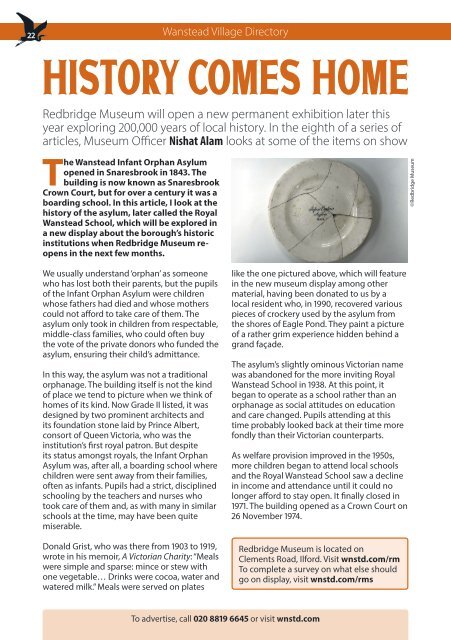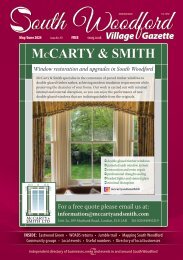September 2022
Create successful ePaper yourself
Turn your PDF publications into a flip-book with our unique Google optimized e-Paper software.
22<br />
Wanstead Village Directory<br />
HISTORY COMES HOME<br />
Redbridge Museum will open a new permanent exhibition later this<br />
year exploring 200,000 years of local history. In the eighth of a series of<br />
articles, Museum Officer Nishat Alam looks at some of the items on show<br />
The Wanstead Infant Orphan Asylum<br />
opened in Snaresbrook in 1843. The<br />
building is now known as Snaresbrook<br />
Crown Court, but for over a century it was a<br />
boarding school. In this article, I look at the<br />
history of the asylum, later called the Royal<br />
Wanstead School, which will be explored in<br />
a new display about the borough’s historic<br />
institutions when Redbridge Museum reopens<br />
in the next few months.<br />
We usually understand ‘orphan’ as someone<br />
who has lost both their parents, but the pupils<br />
of the Infant Orphan Asylum were children<br />
whose fathers had died and whose mothers<br />
could not afford to take care of them. The<br />
asylum only took in children from respectable,<br />
middle-class families, who could often buy<br />
the vote of the private donors who funded the<br />
asylum, ensuring their child’s admittance.<br />
In this way, the asylum was not a traditional<br />
orphanage. The building itself is not the kind<br />
of place we tend to picture when we think of<br />
homes of its kind. Now Grade II listed, it was<br />
designed by two prominent architects and<br />
its foundation stone laid by Prince Albert,<br />
consort of Queen Victoria, who was the<br />
institution’s first royal patron. But despite<br />
its status amongst royals, the Infant Orphan<br />
Asylum was, after all, a boarding school where<br />
children were sent away from their families,<br />
often as infants. Pupils had a strict, disciplined<br />
schooling by the teachers and nurses who<br />
took care of them and, as with many in similar<br />
schools at the time, may have been quite<br />
miserable.<br />
Donald Grist, who was there from 1903 to 1919,<br />
wrote in his memoir, A Victorian Charity: “Meals<br />
were simple and sparse: mince or stew with<br />
one vegetable… Drinks were cocoa, water and<br />
watered milk.” Meals were served on plates<br />
like the one pictured above, which will feature<br />
in the new museum display among other<br />
material, having been donated to us by a<br />
local resident who, in 1990, recovered various<br />
pieces of crockery used by the asylum from<br />
the shores of Eagle Pond. They paint a picture<br />
of a rather grim experience hidden behind a<br />
grand façade.<br />
The asylum’s slightly ominous Victorian name<br />
was abandoned for the more inviting Royal<br />
Wanstead School in 1938. At this point, it<br />
began to operate as a school rather than an<br />
orphanage as social attitudes on education<br />
and care changed. Pupils attending at this<br />
time probably looked back at their time more<br />
fondly than their Victorian counterparts.<br />
As welfare provision improved in the 1950s,<br />
more children began to attend local schools<br />
and the Royal Wanstead School saw a decline<br />
in income and attendance until it could no<br />
longer afford to stay open. It finally closed in<br />
1971. The building opened as a Crown Court on<br />
26 November 1974.<br />
Redbridge Museum is located on<br />
Clements Road, Ilford. Visit wnstd.com/rm<br />
To complete a survey on what else should<br />
go on display, visit wnstd.com/rms<br />
© Redbridge Museum<br />
To advertise, call 020 8819 6645 or visit wnstd.com

















